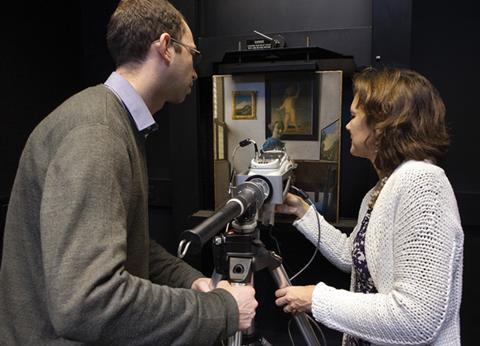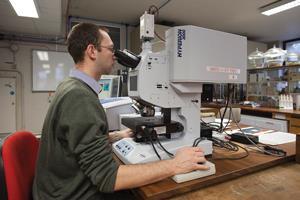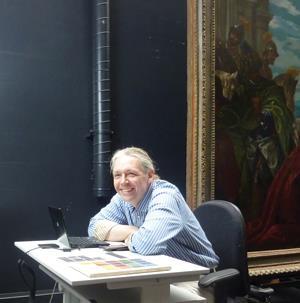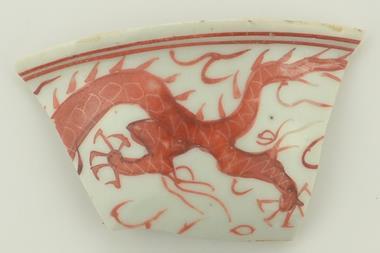Nina Notman meets the National Gallery’s team of analysts, putting masterpieces under the microscope and protecting them for posterity

The tranquil air of the UK’s National Gallery is a welcome respite from the bustle of London’s Trafalgar square. The gallery holds over 2300 artworks painted in western Europe between the 13th and 19th centuries, and each year attracts millions of visitors with masterpieces such as Monet’s Waterlily pond, van Gogh’s Sunflowers and Constable’s Cornfield. But unseen to most of those visitors is the busy team of conservators, curators and scientists working behind each of these scenes to preserve the paintings for future generations. After soaking up the beauty of Monet et al, it feels quite disorientating to be led upstairs and find oneself surrounded by the glassware, chemicals and instruments of an analytical chemistry laboratory.
The National Gallery’s six-person scientific department is headed by Marika Spring. Paintings are brought to her team for a variety of reasons, she explains, but one of their main roles is to support the gallery’s conservation programme. To clean a painting, conservators need to know how it was made and what materials were used, and analytical chemistry can answer those questions.
Peeling back the layers

Many of the gallery’s visitors will appreciate the aesthetic character of its artworks, but Spring and her team enjoy a deeper understanding. They know the paintings as multi-layered, 3D objects. Commonly, a painting consists of canvas on a wooden frame, coated with a preparation (or ground) layer, followed by layers of paint (containing pigments and binder) and then a protective varnish.
Spring examines minute samples – smaller than a pinhead – of the paintings under an optical microscope to look at the layer structure and so begin identifying the pigments. Supporting evidence is obtained using scanning electron microscopy with energy dispersive x-ray microanalysis – to identify the elements present – and Fourier transform infrared spectroscopy reveals the pigments’ molecular structures. Liquid chromatography can also be used to identify dyes from plants or animals in certain pigments.
Examining the organic constituent of pigments falls to David Peggie, for which he also employs GC–MS (gas chromatography–mass spectrometry) – a technique that can identify the paint binder. ‘In our paintings this is normally based on egg yolk, certain kinds of vegetable oil or sometimes glue,’ he explains. GC–MS can also aid identification of a painting’s protective varnish, which the conservators need to know if they hope to remove it.
A broad spectrum
Both Spring and Peggie started out with undergraduate degrees in chemistry – Spring’s from the University of Cambridge, and Peggie’s from the University of Edinburgh. But they took different paths to the National Gallery: Spring trained as a painting conservator and Peggie as an analytical chemist. ‘Conservation science is one of those disciplines that draws on all sorts of skills,’ explains Peggie. ‘There is not one person in the department that has had the same route as any other.’ But they all have one thing in common: a combined passion for the arts and the sciences.
Spring’s eureka moment came as an A-level student. She was studying science subjects but also loved to paint, so when she heard a radio programme about art conservation, ‘I just thought that would suit me down to the ground,’ she explains. After her undergraduate degree, Spring stayed on at Cambridge for a three-year postgraduate diploma in the conservation of easel paintings at the Hamilton Kerr Institute. This was followed by two six-month paid internships, the first with the National Gallery’s scientific department and the second at a private conservation studio. She then returned to the National Gallery as an inorganic analyst, and over the next 22 years rose to become head of the department.

Peggie also enjoyed a little art with his chemistry, spending part of his second undergraduate year studying art history. He spent his fourth year on placement in an AstraZeneca analytical research laboratory, mostly working with high performance liquid chromatography. When he returned to Edinburgh for his final year, Peggie started looking for a PhD, searching for a project that might combine the two. While drinking in the student bar, he learned of the collaboration between the University of Edinburgh and the National Museums of Scotland. Better still, one of the students in that team was about to finish her PhD and a replacement was needed. ‘I couldn’t believe my luck,’ he says.
During his PhD, Peggie developed and applied analytical techniques, mainly liquid chromatography and mass spectrometry, to identify dyestuffs in tapestries. ‘It was very like the work I do here, but with tapestries rather than paintings,’ he explains. At the end of his PhD, when looking for analytical chemistry jobs in industry, he spotted the advert for an organic analyst at the National Gallery, and the rest, as they say, is history.
Colouring in
The gallery’s scientists also participate in collating information about the masterpieces for cataloguing purposes. ‘This technical information becomes a resource for many other purposes,’ explains Spring. They also assist with some of the gallery’s exhibitions. This summer, for example, there is an exhibition on ‘Making colour’.
‘We also have our own research that often comes out of other projects,’ Spring says. ‘We might notice a particular type of pigment degradation on a painting and then decide that we want to do more detailed scientific work to understand that.’
The team uses a wide range of media to disseminate their results. ‘It’s a very multidisciplinary area,’ says Spring. ‘We are trying to reach a number of different audiences, so we will write about our work in many different ways.’ These include the gallery’s website and exhibition catalogues, as well as talks at art history or scientific conferences and papers in scientific journals.
To protect and preserve
The environment inside the National Gallery is carefully controlled to help preserve its priceless paintings, which will inevitably change over time. For example, many of the materials used in the artworks degrade when exposed to light, explains Joseph Padfield, another member of the gallery’s scientific team. ‘But if you kept them in the dark they obviously can’t be seen.’
Theoretically, the paintings could be kept in a low-temperature, oxygen-free environment to stop or retard chemical reactions, but again this wouldn’t be practical. ‘I help decide what measures can be realistically put in place to minimise the natural ageing processes and still display our paintings to their best advantage,’ Padfield continues.

Padfield is also an alumnus of the school of chemistry at Edinburgh. During his undergraduate course, a careers test matched his personality and interests to art conservation and in the final summer holiday of his degree, Padfield travelled to Provincetown in Cape Cod, US, for his first job as a conservator. ‘I was working for a small private museum that was conserving artefacts that had come up from the bottom of the sea,’ he says. When the exhibition he had been working on travelled to Edinburgh the following spring, Padfield juggled further work experience with finishing his degree. ‘That experience helped me apply for a [postgraduate] course in conservation.’ He followed this 18-month MA in the conservation of fine art at Northumbria University in Newcastle, with a further Cambridge-based postgraduate internship in the conservation of easel paintings, at the same institution where Spring did her studies.
The use of digital imaging to assess artworks featured heavily in both of Padfield’s postgraduate courses, giving him the experience needed to join the National Gallery as a Hewlett-Packard imaging research fellow in 2000. He is now a full member of staff, and still using digital imaging to catalogue and document processes during the conservation of paintings. He is also involved in large international collaborative projects looking at how best to share conservation data.
‘My favourite part of my job is that no day is the same,’ Padfield says. And this variety, as well as his passion for the artworks, has kept Padfield at the National Gallery for the past 14 years. Peggie, meanwhile, confides that one of the big draws is being able to meander through the gallery as he heads outside for lunch each day. And as I follow him out of the lab and back into the gallery I completely agree: not many of us enjoy such a picturesque lunchtime stroll.
Read more from our chemistry and art theme issue












No comments yet